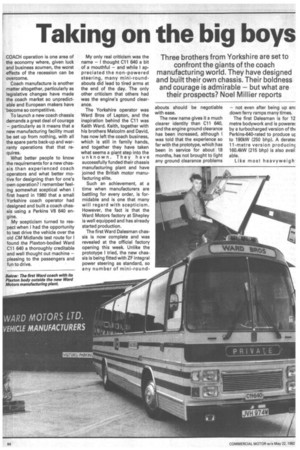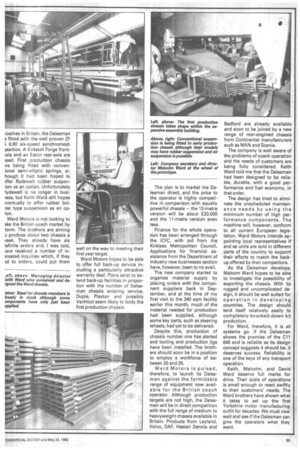Taking on the big boys
Page 76

Page 77

If you've noticed an error in this article please click here to report it so we can fix it.
Three brothers from Yorkshire are set to confront the giants of the coach manufacturing world. They have designed and built their own chassis. Their boldness and courage is admirable — but what are their prospects? Noel Millier reports
COACH operation is one area of the economy where, given luck and business acumen, the worst effects of the recession can be overcome.
Coach manufacture is another matter altogether, particularly as legislative changes have made the coach market so unpredictable and European makers have "become so competitive.
To launch a new coach chassis demands a great deal of courage — particularly as it means that a new manufacturing facility must be set up from nothing, with all the spare parts back-up and warranty operations that that requires.
What better people to know the requirements for a new chassis than experienced coach operators and what better motive for designing than for one's own operation? I remember feeling somewhat sceptical when I first heard in 1980 that a small Yorkshire coach operator had designed and built a coach chassis using a Perkins V8 640 engine.
My scepticism turned to respect when had the opportunity to test drive the vehicle over the old CM Midlands test route for I found the Plaxton-bodied Ward C11 640 a thoroughly creditable and well thought out machine — pleasing to the passengers and fun to drive.
My only real criticism was the name — 1 thought C11 640 a bit of a mouthful — and while I appreciated the non-powered steering, many mini-roundabouts did lead to tired arms at the end of the day. The only other criticism that others had was the engine's ground clearance.
The Yorkshire operator was Ward Bros of Lepton, and the inspiration behind the C11 was Keith Ward. Keith, together with his brothers Malcolm and David, has now left the coach business, which is still in family hands, and together they have taken what seems a giant step into the unknown. They have successfully funded their chassis manufacturing plant and have joined the British motor manufacturing elite.
Such an achievement, at a time when manufacturers are battling for every order, is formidable and is one that many will regard with scepticism. However, the fact is that the Ward Motors factory at Shepley is well equipped and has already started production.
The first Ward Dalesman chassis is now complete and was revealed at the official factory opening this week. Unlike the prototype I tried, the new chassis is being fitted with ZF integral power steering as standard, so any number of mini-round
abouts should be negotiable with ease.
The new name gives it a much clearer identity than C11 640, and the engine ground clearance has been increased, although I was told that the experience so far with the prototype, which has been in service for about 18 months, has not brought to light any ground clearance problems — not even after being up an down ferry ramps many times.
The first Dalesman is for 12 metre bodywork and is powere( by a turbocharged version of th( Perkins-640-rated to produce (4 to 190kW (250 bhp). A derate( 11-metre version producinc 160.4kW (215 bhp) is also avail able.
Like most heavyweigh ;oaches in Britain, the Dalesman s fitted with the well proven ZF ; 6.80 six-speed synchromesh jearbox. A Kirkstall Forge frontode and an Eaton rear-axle are ised. First production chassis ire being fitted with convenional semi-elliptic springs, alhough it had been hoped to )ffer Rydewell rubber suspen;ion as an option. Unfortunately iydewell is no longer in busiless, but Keith Ward still hopes iventually to offer rubber bol;ter type suspension as an opion.
Ward Motors is not looking to ake the British coach market by term. The brothers are aiming a produce about two chassis a veek. They already have six lefinite orders and. I was told, lave received a number of inerested inquiries which, if they ad to orders, could put them well on the way to meeting their first year target.
Ward Motors hopes to be able to offer full back-up service including a particularly attractive warranty deal. Plans exist to extend back-up facilities in proportion with the number of Dalesman chassis entering service. Duple, Plaxton and possibly VanHool seem likely to body the first production chassis. The plan is to market the Dalesman direct, and the price to the operator is highly competitive in comparison with equally powerful chassis — the 12-metre version will be about £20,000 and the 11-metre version even less.
Finance for the whole operation has been arranged through the ICFC, with aid from the Kirklees Metropolitan Council. Applications for financial assistance from the Department of Industry new businesses section have, however, been to no avail.
The new company started to organise material supply by placing orders with the component suppliers back in September, and at the time of my first visit to the 240 sqm facility earlier this month, much of the material needed for production had been supplied, although some key parts, such as steering wheels, had yet to be delivered.
Despite this, production of chassis number one has started and tooling and production jigs have been installed. The brothers should soon be in a position to employ a workforce of between 20 and 25.
Ward Motors is poised, therefore, to launch its Dalesman against the formidable range of equipment now available for the British coach operator. Although production targets are not high, the Dalesman will be in direct competition with the full range of medium to heavyweight chassis available in Britain. Products from Leyland, Volvo, DAF, Hestair Dennis and Bedford are already available and soon to be joined by a new range of rear-engined chassis from Continental manufacturers such as MAN and Scania.
The company is well aware of the problems of coach operation and the needs of customers are being fully considered. Keith Ward told me that the Dalesman had been designed to be reliable, durable, with a good performance and fuel economy, in that order.
The design has tried to eliminate the unscheduled maintenance needs by using the minimum number of high performance components. The machine will, however, conform to all current European legislation. Ward Motors intends appointing local representatives if and as units are sold in different parts of the country to support their efforts to match the backup offered by their competitors.
As the Dalesman develops, Malcom Ward hopes to be able to investigate the possibility of exporting the chassis. With its rugged and uncomplicated design, it should be well suited for operation in developing countries. The design should lend itself relatively easily to completely-knocked-down kit production.
For Ward, therefore, it is all systems go. If the Dalesman shows the promise of the C11 640 and is reliable as its design concept suggests it should be, it deserves success. Reliability is one of the keys of any transport operation.
Keith, Malcolm, and David Ward deserve full marks for drive. Their scale of operations is small enough to react swiftly to their customers' needs. The Ward brothers have shown what it takes to set up the first Yorkshire motor manufacturing outfit for decades. We must now wait and see if the Dalesman can give the operators what they want.






























































































